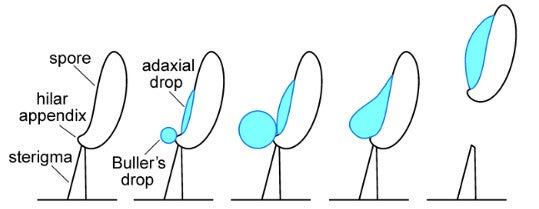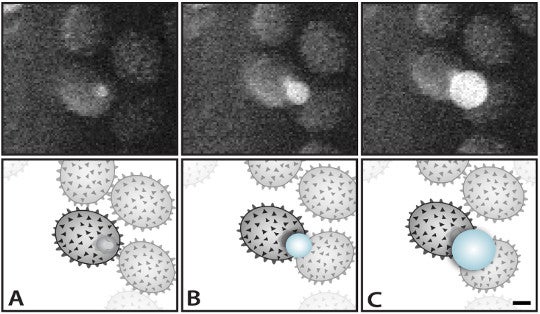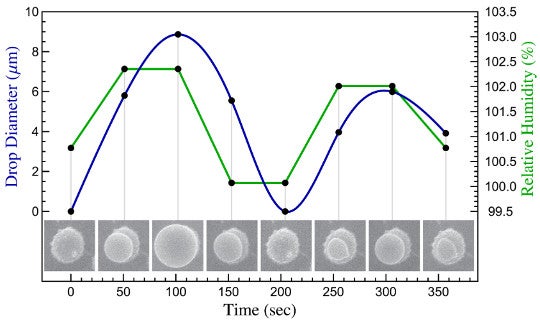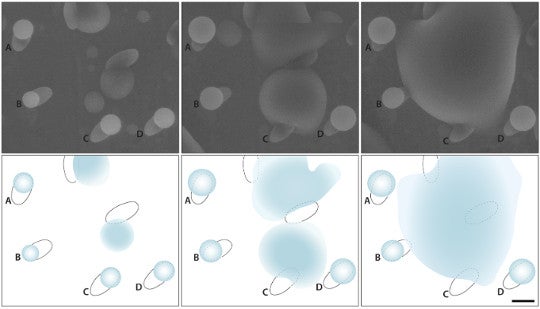This article was published in Scientific American’s former blog network and reflects the views of the author, not necessarily those of Scientific American
Every year, fungi make 50 million tons of airborne spores—enough to coat every square millimeter of Earth’s surface with 1,000 spores each. The mass of those spores would balance 137 Empire State Buildings, 527 USS Enterprises (the aircraft carrier, not the starship)—or about 20 million Oscar Mayer Weinermobiles.
We know why the fungi are making those spores, and we know why they are floating around in the atmosphere: to disperse their parents’ genes. But with all those spores up there, one has to wonder if anything else might be going on – as some scientists at Miami University in Ohio and Mount St. Joseph University in Cincinnati recently did.
Most of the fungal spores floating around in the atmosphere are made by mushrooms. Mushrooms are basidiomycetes, a vast group of fungi that get their name from the way they make their spores. Basidiospores grow from basidia – club-shaped cells with four terminal prongs called sterigmata. The spores inflate from the tips of these prongs like balloons. There are four because these cells' nuclei are the four products of meiosis—sexual cell division—within the basidium.
On supporting science journalism
If you're enjoying this article, consider supporting our award-winning journalism by subscribing. By purchasing a subscription you are helping to ensure the future of impactful stories about the discoveries and ideas shaping our world today.

Section of a mushroom gill from the genus Coprinus. A=sterigma, B=basidium, C=basidiospore, D=Immature basidium. Scale bar = 0.01mm.By Jon Houseman - Jon Houseman and Matthew Ford, CC BY-SA 3.0, https://commons.wikimedia.org/w/index.php?curid=33000998
Many basidiospores – those produced by the 16,000 described species of mushrooms along with the plant parasites called rust fungi and some yeasts -- have a fascinating ballistic spore dispersal mechanism powered by water and a small amount of sugar. It has been described as a “surface tension catapult”, and it gives the spores that engage in it the name “ballistospores”. (The mechanics of our modern understanding of this process were laid out in the refreshingly titled “More g’s than the Space Shuttle: Ballistospore Discharge” in

How a mushroom spore is launched. Fig. 1 from Hassett et al. 2015.
Mycologia back in 1998.)
The spore bears a tiny projection called the hilar appendix. At the tip, the fungus secretes sugars including mannitol and a variety of hexoses. Sugars are hygroscopic, which means they have a tendency to absorb water from the environment (as seen in many a bag of clumpy sugar). This sugar sheen promotes condensation on the hilar appendix when it’s humid, forming a tiny body of water called Buller’s drop. Meanwhile, water is also collecting on the spore surface nearby. This is called the adaxial drop.
At some point Buller’s drop gets big enough to touch the adaxial drop, and the droplets fuse suddenly due to the force of surface tension. When this happens, the center of gravity of the spore lurches sideways. The force is opposed by the attachment to the sterigma, which is inflated at high pressure. The isthmus between the spore and sterigma breaks, flinging the spore off its sterigma with an acceleration of about 25,000 g, which, as advertised, is 10,000 times the force astronauts experienced during shuttle launches. And while the space shuttle consumed half of its weight in fuel during its first two minutes of flight, the sugar fuel of a ballistospore’s hilar appendix water trap represents only 1% of its weight.
Of course, in NASA’s defense, the space shuttle actually left Earth’s atmosphere. The ballistospore’s aim is simply not to get hung up on its mushroom on its way to the nearest gentle breeze, and it rapidly slows post-launch due to air resistance, then falls toward Earth as gravity takes over.
Now airborne, the spore drifts down through the gills or tubes of its mushroom and finds itself afloat on whatever air currents lie beneath. Some of these air currents will carry some of these spores into the atmosphere, where they find themselves adrift in a sea of air, particles, and clouds.
Condensation, of course, is one of the most important things that happens in the atmosphere. It is the genesis of everything from clouds to rain, snow, thunderstorms, tornadoes, and hurricanes. To condense at the temperatures we are accustomed to, water requires a solid surface on which to alight. The motley crew of particles floating in the atmosphere form a convenient source of such surfaces. Clouds – and eventually rain – condense around these particles, which scientists have given the glorified title of cloud condensation nuclei. Lots of things can act as CCNs – dirt, dust, soot, sea salt, pollen, plant spores, and bacteria. So scientists wondered – what about all these millions of tons of fungal spores hanging out up there with nothing else to do?
The water that launches a ballistospore evaporates sometime after liftoff. But the sugars that promoted its condensation remain. The mannitol deposited there is so characteristic of fungi that it is used by scientists as a gauge of just how many spores are in the atmosphere – and is how we know that 50 million tons blitz our atmosphere every year. That sugar glaze could theoretically catalyze the condensation of yet another droplet. Yet no one had studied the post-launch hygroscopic properties of mushroom spores before to see if that actually can happen.
To that end, Maribeth Hassett and Nicholas Money of Miami University in Ohio and Mark Fischer of Mount St. Joseph University teamed up to find out. They incubated basidiospores from seven different species in humidity chambers at various relative humidities. They discovered that large drops of water indeed reformed on shot spores held at 102% relative humidity – a typical level of supersaturation found in clouds. Either Buller’s Drop or the adaxial drop would reform – usually the adaxial – but never both.

Droplet formation at 102% relative humidity on the hilar appendix of a basidiospore from the mushroom Russula aeruginea. A) Shows spore prior to droplet formation with hilar appendix facing camera. B) and C) Droplet forms and expands. Scale bar two micrometers. Fig. 3 from Hassett et al. 2015.
When the relative humidity dropped below 100% the drop vanished. But the drop could be stimulated to reform multiple times through cycles of hydration and dehydration.

Droplet growth and evaporation in response to changing humidity. Fig. 5 from Hassett et al. 2015.
Although the droplets that formed on the site of Buller’s drop never exceeded the size found during normal spore dispersal, those that formed on the site of the adaxial drop grew much larger. Some exceeded the diameter of the spore, and when they got large enough, they merged with the droplets formed on nearby spores, making one mega-drop.

Water drops growing on spores of the mushroom Suillus brevipes at 101% relative humidity. Growing droplets merge in middle and at right. Scale bar five micrometers. Fig. 6 from Hassett et al. 2015.
Since we now know that ejected mushroom spores can accumulate water in humid environments, it’s possible – perhaps likely -- they play an important role in rain-making over forests. Many people may imagine rain drops form from the merger of lots and lots of teeny tiny droplets which gradually grow to enormous size, but experiments show that that isn’t the case. Large CCN’s with diameters over two micrometers are very important rain seeds in clouds. They function as “giant cloud condensation nuclei” (GCCNs), which form the large raindrops we know and love by striking and fusing with the teeny tiny droplets and merging with drops around other GCCNs. Fungal spores likely serve as excellent GCCNs.
As a result, there may be a vast and previously unrecognized positive feedback loop acting over forests. Mushrooms, which spring up like tulips after a good soaking, themselves make spores that act as rain seeds, which makes the rain that makes more mushrooms. The authors of the paper believe this must be purely unintentional on the mushrooms’ part. “There is no adaptive significance to the putative effect of spores on cloud formation," the wrote. "It is a consequence of the dispersal mechanism that happens to benefit the fungus beyond its effectiveness at distributing spores."
However, this effect has a very important implication. If climate change reduces rainfall over forests in the tropics and elsewhere, as many have forecast that it will, the resulting drop in mushroom spore formation could make droughts more frequent and harsher, as the flip side of the fungal-rain feedback loop rears its ugly head.
Note: This post was inspired by a post on the same paper over at Small Things Considered. Go check it out too!
Reference
Hassett, Maribeth O., Mark WF Fischer, and Nicholas P. Money. "Mushrooms as Rainmakers: How Spores Act as Nuclei for Raindrops." PloS one 10, no. 10 (2015): e0140407.
Money, Nicholas P. "More g's than the Space Shuttle: ballistospore discharge." Mycologia (1998): 547-558.